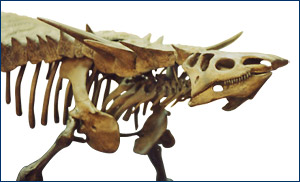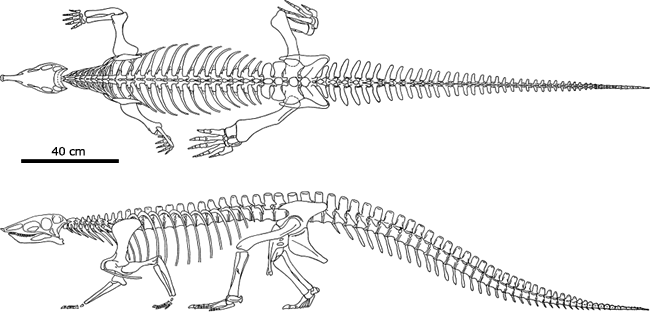
Aetosauria
Bird-headed, pig-snouted, armored reptiles
 The aetosaur Desmatosuchus. |
Aetosaurs have only been found in sediments of the Upper Triassic, when all the land of the world was joined together in the supercontinent Pangea. This vast continent had immense implications for the weather where aetosaurs lived. The huge continent caused large monsoonal weather patterns. Most likely, the areas where aetosaurs lived were quite wet, with long rainy seasons and meandering streams. This can be deduced from the shales in which aetosaurs are found because shales are formed when mud is compacted under great pressure for long periods of time. Aetosaurs thus lived in wet environments like modern alligators, and wherever fossils of aetosaurs are found, it is possible to deduce the paleoenvironment of that locality.
Fossils of aetosaurs have been found in Europe and in North and South America, though they may have had a worldwide distribution. The most famous aetosaur localities are Elgin, Scotland, where Aetosaurus and Stagonolepis were found, and the Chinle Formation of western North America where we find Desmatosuchus. The most commonly found aetosaur fossils are the bony scutes, or plates, which make up the body armor.
 A restoration of the aetosaur Stagonolepis showing the arrangement of bony scutes. |
Aetosaurs were sizeable reptiles that grew to be one to five meters long, the average being about three meters (10 feet). They were protected by an armor that covered the neck and the upper and under surfaces of the trunk and tail. Some species, such as Desmatosuchus, also had heavy spikes along the shoulders and flanks. Based on their fossils and the fact that they were herbivores, aetosaurs probably relied on their armor and large size rather than speed to protect them from predators.
 Dorsal and lateral views of the restored skeleton of Stagonolepis. |
Aetosaurs not only resembled crocodiles superficially, but were close relatives. Both aetosaurs and crocodiles belong to the Pseudosuchia, a group that also includes the phytosaurs. The Pseudosuchia in turn belongs to the larger group Archosauria that includes the dinosaurs. Like their dinosaur relatives, aetosaurs' legs were positioned directly beneath the hip joint, a feature that makes walking on land more efficient. However, the short, robust limbs suggest it may have moved much like the modern crocodile.
Also like dinosaurs and crocodilians, aetosaurs probably built nests and protected their eggs. In 1996, geologist Stephen Hasiotis discovered 220 million-year-old, fossilized, bowl-like nests in Arizona's Petrified Forest, in part of the Chinle Formation. This is a time when some reptiles stopped laying their eggs directly on the soil and started protecting them, and the oldest such nests that have been found there belonged to the phytosaurs and the aetosaurs. The nests are compacted and appear to be very similar to the nests of the modern day crocodiles who guard their nests. They were holes originally dug out of the sand along the bend of an ancient river.
The aetosaurs were primarily herbivorous animals, and were the first group of archosaurs to begin eating plants. Most likely, they fed on leaves and foliage from various ferns and "seed ferns" that were prevalent in their habitat. They had disproportionately small heads with small spoon- or leaf-shaped teeth, though oddly all their teeth are found in the upper jaw. Aetosaurs had a pig-like snout with a toothless tip shaped into a small shovel-like ridge, perhaps useful for digging up roots, rhizomes, and tubers. This might have compensated for the fact that the front feet of aetosaurs were small and clawless. Some aetosaurs had wide, turtle-shaped midsections that probably accommodated a large fermenting gut, a characteristic found in some later herbivorous dinosaurs. Although it is generally accepted that aetosaurs were herbivorous creatures, one specimen from Texas (Saurosuchus) may have been carnivorous or omnivorous. This specimen has backward pointing sharp teeth that are thought to have been used to hold and rip flesh.
 Dorsal and lateral views of the skull of Stagonolepis. |
Aetosaurs became extinct at the end of the Triassic, when a mass extinction eliminated most groups of pseudosuchians and many groups of synapsids.
For more about aetosaurs, visit palaeos.com or Ben Creisler's Aetosauria Translation and Pronunciation Guide.
Sources
|
||
Original text written and completed 5/2000 by Karl Ziehn, Emma Sangalang, Lillian Fritz-Laylin, Charlene Twu, and Anhthy Huynh as part of a Biology 1B project under Brian R. Speer, GSI; additional text by Matt Wedel, 5/2007;Desmatosuchus photo © Robert Gay; Stagonolepis images used with permission of the Royal Society of London: from Walker, A.D. 1961. Triassic reptiles from the Elgin area: Stagonolepis, Dasygnathus and their allies. Philosophical Transactions of the Royal Society of London, B 244:103-204